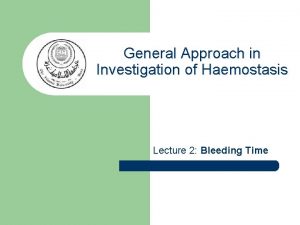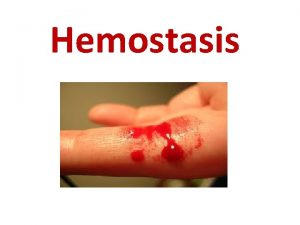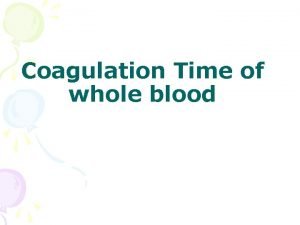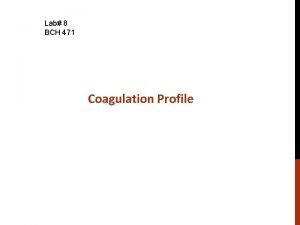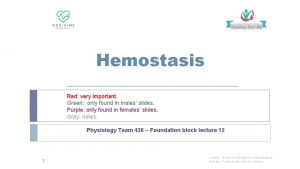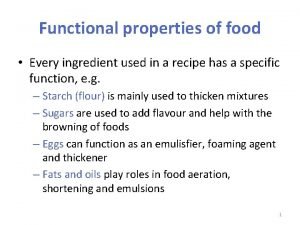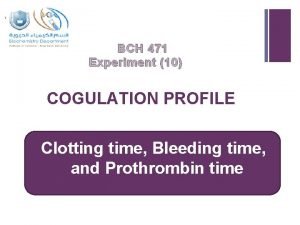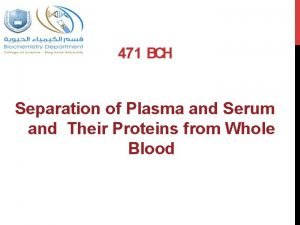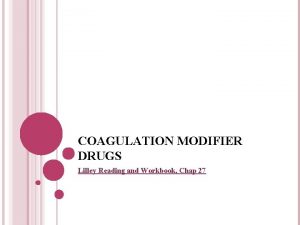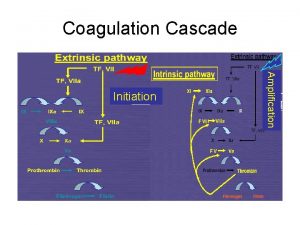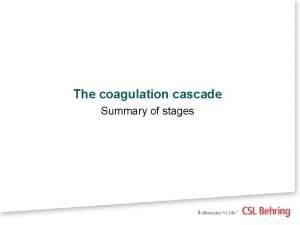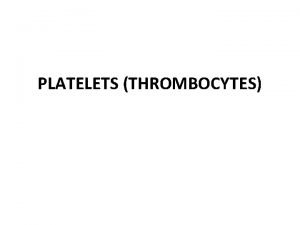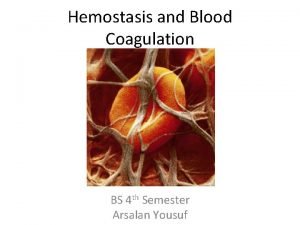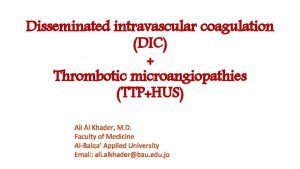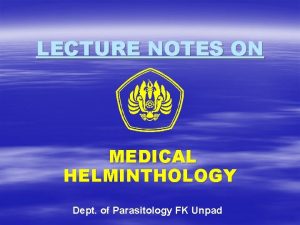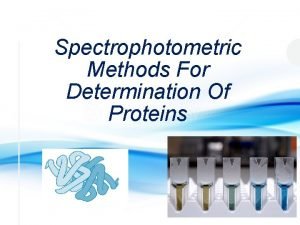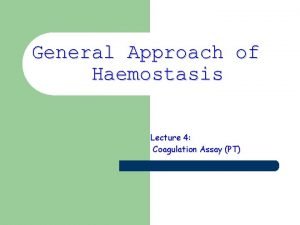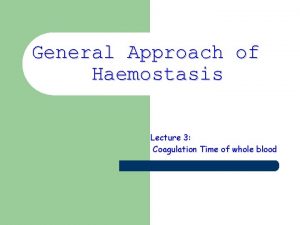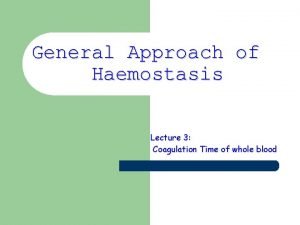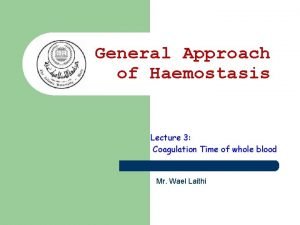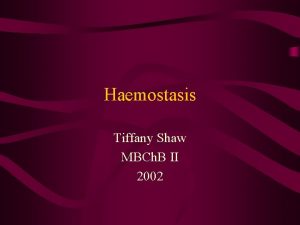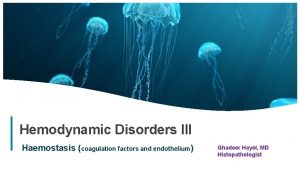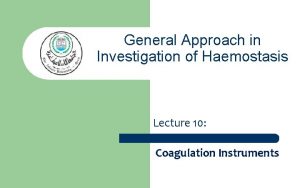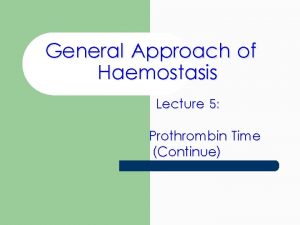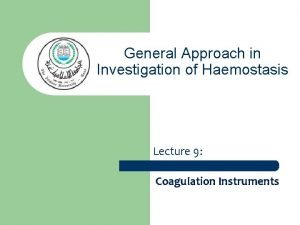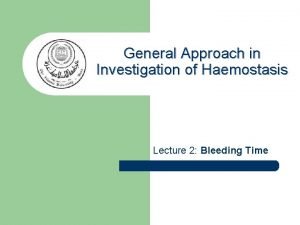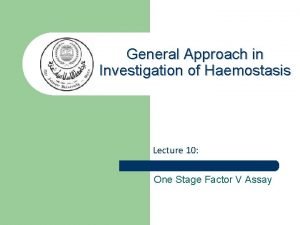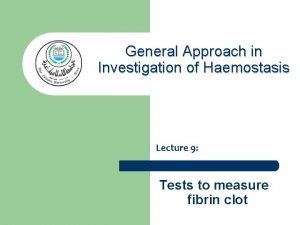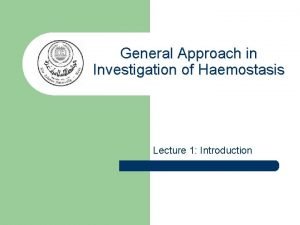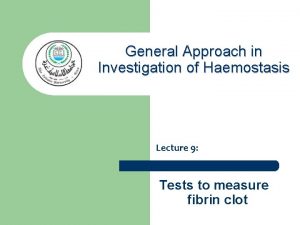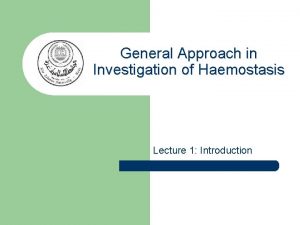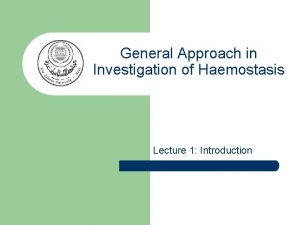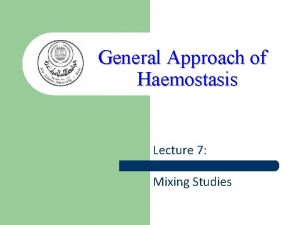General Approach of Haemostasis Lecture 4 Coagulation Assay


























- Slides: 26

General Approach of Haemostasis Lecture 4: Coagulation Assay (PT)

Protime /Prothrombin (PT) Prothrombin time is the time required for the plasma to clot after an excess of thromboplastin and an optimal concentration of calcium have been added. Although the PT was originally described as a specific, one-stage assay of prothrombin (FII), it is sensitive to a quantitative or qualitative abnormalities of any of the factors involved in the extrinsic and common pathways of the coagulation system (Factors II, V, VII, X, and Fibrinogen).

The PT used to determine the clotting tendency of blood, in the measure of warfarin dosage, liver damage, and vitamin K status. Occasionally, the test may be used to screen patients for any previously undetected bleeding problems prior to surgical procedures.

6

The Test The Standard operating Procedure Ø Ø Ø Ø Ø Procedure name Clinical significance Principle of method Specimen of choice Reagents and equipments Procedure Reference values Comments References Principle

Principle: When reagent thromboplastin--to which calcium has been added--is mixed with plasma (derived from sodium citrated whole blood), the time (in seconds) it takes for the formation of a clot is reported as the Prothrombin time (PT). Calcium is necessary for the correct orientation and binding of a number of complexes including : tissue factor-VIIa, IXa-VIIIa, and Va-Xa.


PT Reagent v v Thromborel® S Reagent: lyophilized human placental thromboplastin, calcium chloride, stabilizers Thromboplastin may be obtained from other sources like Rabbit brain or lung tissue Neoplastine® C 1 Plus - lyophilized fresh rabbit brain thromboplastin with a specific heparin inhibitor hydrated with a solvent containing calcium with stabilizers, polybrene, buffer and preservatives. (Tissue Factor, coagulation factor III ) protein-lipid complex found in tissues outside blood vessels. It is the combination of both phospholipids and tissue factor, both needed in the activation of the extrinsic pathway*.

v Recombinant thromboplastin has been produced using human tissue factor in Escherichia coli. These synthetic phospholipids do not contain any other clotting factors such as Prothrombin, factor VII, and factor X. v Therefore they are highly sensitive to factor deficiencies and oral anticoagulant–treated patient plasma samples and have an International Sensitivity Index (ISI) close to 1.

SPECIMEN v Citrated plasma: 1 part of sodium citrate solution (0. 11 mol/ L) to 9 part of venous blood, avoiding the formation of foam. v Control: normal plasma (Commercial, Pooled Plasma)

Calibration of Reagent Each Thromboplastin Reagents must be calibrated against standard PT reagent established by the WHO. ISI = International Sensitivity Index. ISI is assigned by the manufacturer for each lot of reagent using reference material from WHO. The lower the ISI the more sensitive the Reagent 1. ISI of 1. 8 to 2. 4 = Low sensitivity 2. ISI of 1. 4 to 1. 8 = Average sensitivity 3. ISI 1. 0 to 1. 4 = High Sensitivity

EQUIPMENTS Ø Ø Ø Ø 100 μL micropipettes (0. 10 m. L) 200 μL micropipettes (0. 20 m. L) Stop Watch. Thromborel® S Reagent Racks Test tubes Waterbath (37ºC) Waste containers/ Biohazard bags

Procedure q q Reconstitute tissue thromboplastin according to instructions. Label the thromboplastin with the time, date and initials. The thromboplastin reagent is stabile for 7 days after reconstitution. Allow to sit 10 -15 minutes, then invert gently several times. Mix well prior to pipetting any of this reagent at any step in this procedure. Prewarming of the reagent by pipetting 1 -2 mls, using a plastic pipette, of the tissue PT reagent into a glass test tube and place in a 370 C water bath incubator.

q Pipette 100 µL of normal control, Patient PPP into each of the test tubes. q Allow at least one (1) minute to reach 37°C. q Pipette 200 µL of PT reagent into the tube containing the control. Start the stop watch simultaneously. q Mix the tube and leave in the water bath for a minimum of 7 -8 seconds. Then remove, wipe the exterior, tilt back and forth gently until a visible clot is formed. As the clot forms, the mixture will gelatinize and may turn cloudy. q Stop the stop watch and record the result. If the results from run 1 and run 2 are within + 10% second from each other, average the two results and report with appropriate units.

q If results are not within required limits, a third run should be performed and average the two that match within acceptable limits. Be sure and cross out any values you are not using for the final calculation. Include measurement unit of seconds on report sheet. q Carry out 1 significant figure passed the decimal point. For example, if your result is 12. 23 seconds, report as 12. 2 seconds. q Repeat the procedure for the samples and Record the time.

Results are expressed as the mean of the duplicate reading in: Ø Seconds Ø Prothrombin ratio Ø International Normalized Ratio (INR)

Reference ranges q PT: 11. 0 – 13. 0 seconds. q Therapeutic levels are at a P/C ratio of 2. 0 – 3. 0 q CRITICAL VALUES* PT critical value changed to > 42. 1 seconds; INR changed to > 4. 5 * (Refer to PCS Policy 7. 01. 05 Reporting Critical Values for reporting guidelines)


When is it ordered? Used to monitor oral anticoagulant therapy (Warfarin / Coumadin). When a patient who has signs or symptoms of a bleeding disorder. When a patient is to undergo an invasive medical procedure, such as surgery, to ensure normal clotting ability.

An elevated Prothrombin time may indicate the presence of 1. 2. 3. 4. 5. Vitamin K deficiency DIC, Liver disease, Presence of FSP’s A deficiency in one or more of the Concerning factors: Factor I (Fibrinogen), Factor II (Prothrombin), Factor V (Proaccelerin, Labile Factor), Factor VII (Proconvertin, Stable Factor, Factor X (Stuart-Prower Factor, Factor XIII (Fibrin Stabilizing Factor) 6. In addition, inhibitors can cause prolonged PT’s.

Interpretation of Result q q q A Normal Plasma is used to evaluate routine result. The INR is not calculated to evaluate Routine PT results. For Patients who are on oral anticoagulant therapy such as Coumadin INR result must be reported. Standardization of Report from lab to lab, by using INR results. Patients with lupus anticoagulants are not be requested for PT as they have antiphospholipid.

Interfering Factors r r r Diet: ingestion of excessive green, leafy vegetables will increase the absorption of vit-K, which promotes blood clots. Alcoholism, Prolonged PT levels Diarrhea and vomiting decrease PT because of dehydration. Quality of Vein puncture. Medication : Antibiotics , Aspirin, Cimethidine…. Prolonged Storage of plasma at 4 o C.

Sources of Error 1. Associated with specimen (Preanalytical) a. Inappropropriate ratio of anticoagulant to blood b. Failure to correct citrate volume if hematocrit > 55% c. Clotted, hemolyzed or lipemic samples d. Lack of PPP e. Delay in testing or processing f. Inappropriate storage

Sources of Error 2. Associated with Reagent (Analytical) 2. Incorrect preparation of reagents 3. Use of reagents beyond reconstituted stability time or expiration date 4. Contaminated reagent. 3. Associated with procedure (Analytical) 2. Incorrect temperature 3. Incorrect incubation times 4. Incorrect volumes of sample, reagents or both

http: //site. iugaza. edu. ps/wael/courses/practical-haemostasis-and-thrombosis http: //site. iugaza. edu. ps/ialaswad/courses/practical-hemostasis-thrombosis/lectures/ Next Lecture:

 Ivy method
Ivy method Clotting factors
Clotting factors 01:640:244 lecture notes - lecture 15: plat, idah, farad
01:640:244 lecture notes - lecture 15: plat, idah, farad Surgical diathermy block diagram
Surgical diathermy block diagram Disseminated intravascular coagulation pathophysiology
Disseminated intravascular coagulation pathophysiology Clotting time - slide method procedure
Clotting time - slide method procedure Coagulation pathway made easy
Coagulation pathway made easy Coagulation profile test
Coagulation profile test Pycnose reversible
Pycnose reversible Vasoconstriction
Vasoconstriction Examples of dextrinisation
Examples of dextrinisation Twisted strands of egg white
Twisted strands of egg white Coagulation profile test
Coagulation profile test Separation of serum
Separation of serum Slidetodoc.com
Slidetodoc.com D'alessio
D'alessio Coagulation modifier drugs
Coagulation modifier drugs Coagulation disorders
Coagulation disorders Protein denaturation definition
Protein denaturation definition Coagulation cascade
Coagulation cascade Dicoumoral
Dicoumoral Blood clotting mechanism
Blood clotting mechanism Disseminated intravascular coagulation
Disseminated intravascular coagulation General parasitology lecture notes
General parasitology lecture notes General medicine lecture
General medicine lecture General parasitology lecture notes
General parasitology lecture notes Bradford reagent structure
Bradford reagent structure
